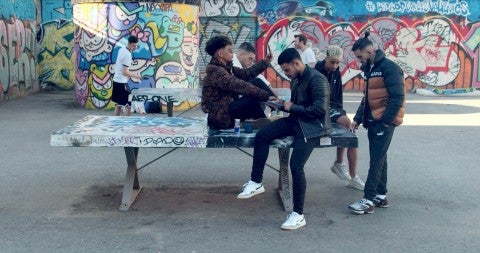Inspired by his personal history and experiences, artist, curator, and educator Arash Fayez explores themes of displacement and liminality in his work. He investigates the emotional and physical effects of desire and displacement arising from immigration. Born in Iran and currently residing in Barcelona, Fayez employs storytelling techniques to create texts, videos, performances, and photographs that blend personal experiences with both fictional and nonfictional content. He aims to “construct an emotional landscape that resonates with the in-between.”
Fayez’s early works focus on how immigrants physically adapt to new environments. The first work he created after moving to the United States from Iran was Yek Video-ye Bedoun-e Onvān (2013), a video in which Fayez shaves his beard using a razor and scissors. His ongoing performance Official Announcement (Accent) (2016) features the artist attempting to convert his imperfect American accent into one known as Received Pronunciation, a style of speech associated with the middle and upper classes in the United Kingdom. In his 2014 lecture-performance Could Smell Arak Lingering on my Breath When I Pulled the Trigger, Fayez examines the psychological toll on immigrants who are coerced—if not forced—to perform false versions of themselves to fit into new environments.
More recent works examine the role of the state and government in shaping the status and experiences of immigrants, as well as how individuals navigate various restrictions and obstacles in response. An Untitled Performance in Collaboration With an Ex-Lover (2017) revolves around Fayez, who was living in California at the time, and his ex-lover, who resided in Montreal, Quebec. He asked her to meet him at the U.S.-Canada border because he could not leave the United States due to his expired visa, and she was unable to enter the United States because of Executive Order 13769, commonly known as the “Muslim Travel Ban.” In On Betweenness (2019), Fayez presented a lecture-performance with slides that investigates the word “and” as a conjunction or a segment that links two concepts. The work calls attention to what exists between two things, highlighting the experience of being caught between two countries, cultures, or identities.
The year before On Betweenness, Fayez began developing Apolis (2018–21). After earning his MFA degree from the California College of the Arts (CCA), Fayez was arrested in San Francisco in 2014 for overstaying his student visa. Following four years of uncertain legal status, he voluntarily left for London. Apolis recounts this experience with the 312 pages of his complete U.S. immigration dossier along with photographs of himself taken during the four years of limbo, comparing official and personal representations of his experience. Apolis, the title of which refers to the Ancient Greek word ápolis, meaning “without city, state or country,” concludes with documentation of Fayez’s journey to regularize his legal status in Spain.
Now based in Barcelona, Fayez created I Can Only Dance to One Song (2021), a video that, while rooted in feelings of desire and longing, also conveys moments of joy and pleasure. It features several people listening, singing, and dancing to music of their choice in a range of public and private settings. The video begins with a man who sings along to a song at the barber shop. Next, a woman dances to another song in an empty room within a religious or educational building. In a food market, to a different tune, a cashier moves through the aisles of his store passionately dancing and mouthing lyrics. The film then cuts to a group of young men hanging out in a graffiti-filled lot, where they rap along to the song playing from their stereo. It concludes with a lone woman swaying in an empty gymnasium, followed by a man at a butcher shop smiling and snapping along to the same song.
Instead of feeling obligated to change themselves in ways against their wishes, the characters in I Can Only Dance perform physical acts that create a palpable sense of belonging through music. These universally understood expressions of song and dance enhance their connections to their cultural roots and origins while navigating a new or different environment. Moreover, Fayez captures the vibrant multicultural enclave of the Raval district in Barcelona, emphasizing the city’s diverse, cosmopolitan nature and highlighting the power of cultural exchange, rather than the complete assimilation of immigrant communities. —Kanitra Fletcher

